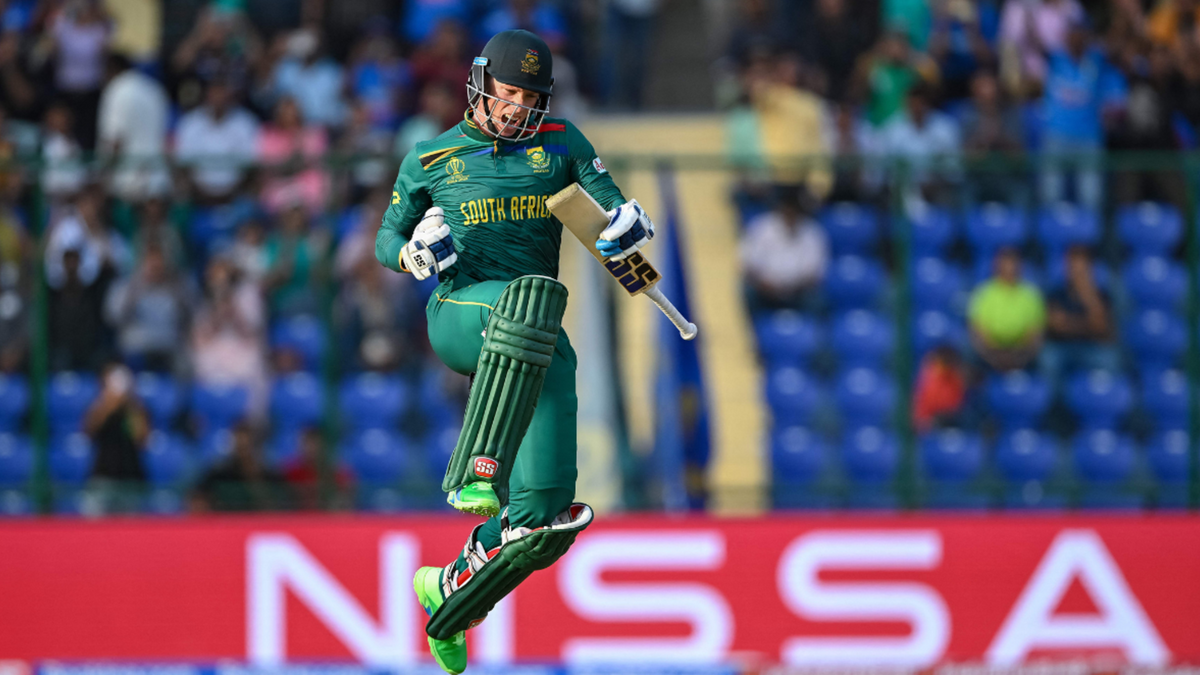
Rassie van der Dussen sticks out in South Africa’s team of thunderous big hitters, but his understated mountain of runs could be their silent weapon, writes Katya Witney.
To bet on the World Cup with our Match Centre Partners bet365 head here.
South Africa were 8-1 in their opening World Cup match in Delhi when Rassie van der Dussen came to the crease. In the build-up to the tournament, South Africa were billed as the boom-or-bust side, the one that could reach the semi-finals or finish in the bottom third of the table. They could easily have played true to that prediction ten minutes into their campaign, with an opener down less than two overs into the match.
Instead, the very next ball sent down by Dilshan Madushanka pinged off van der Dussen’s bat and down to the backward square boundary. No sooner was the ball fetched and back in Madushanka’s hands was the fielder sent to retrieve the ball from the same place once again, this one a slightly less convincing shot but still yielding the same results.
Those were warning blasts from van der Dussen, a precursor to the main assault. He didn’t hit another boundary inside the powerplay, reaching 19 off 28 before sounding the bugle to announce the cavalry charge. An imperious six over long off, an edge down to the third man boundary and a glorious cover drive later, suddenly the danger seemed more imminent for Sri Lanka.
South Africa’s team of big hitters, coupled with their fiery pace attack, look an intimidating prospect on paper. They piled on huge scores against Australia in the weeks before the tournament, and no side has scored their runs more quickly in ODIs this year.
But, when debating pre-tournament favourites, an air of uncertainty tinged South Africa’s chances. Those totals they’d put on against Australia were on flat pitches against an attack without Mitchell Starc, Pat Cummins and co. Previously this year, they’d registered a series win against an England side that looked vastly different to the one currently attempting to defend their World title, and lost and then won against the 10th- and 14th-ranked sides in the world respectively.
For all their obvious successes, the caveats were numerous. The same is true of van der Dussen. A look at his stats shows all the criteria of a world-class ODI player met. The average is close to 60 (58.29); the strike rate near 90 (89); and before Saturday he had four centuries and 12 fifties to his name. Three of those hundreds came in the last two years.
Yet, of all South Africa’s batters, his place was the one most under threat. After scoring 111 against England in January, eight innings passed in which he failed to reach fifty. He scored 62 against Australia before Heinrich Klaasen and David Miller quickly eclipsed his return to form with their record-breaking late-innings bonanza at Centurion.
It was the same case in Delhi when he truly found his groove again. It took him 15 balls to move from 90 to three figures, a space of five overs where Quinton de Kock had reached his own century, then got out, and Aiden Markram had scored the first four of his 17 boundaries.
Amid the emerging carnage, a single eased down the ground, a roar of satisfaction before a self-contained fist pump brought van der Dussen his hundred off 103 balls. An attempted heave over long-on brought his innings to an end three overs later. Leave that kind of nonsense to the others.
A fifth ODI century in his 50th ODI for Rassie van der Dussen 👏#SAvSL #CWC2023 pic.twitter.com/W0zMn41plE
— Wisden (@WisdenCricket) October 7, 2023
Markram will rightly bask in the limelight of his record-breaking blitz, which lasted less than half of van der Dussen’s innings but yielded only two fewer runs. De Kock, too, on his farewell tour, has a larger share of the post-match limelight than van der Dussen. But, if South Africa are to prove their doubters wrong, van der Dussen may prove to be the most important.
That aggression comes at a cost, with six specialist batters and few all-rounders leaving a long tail: none of South Africa’s bottom four average more than 16 with the bat. When those six batters come off, innings like Saturday’s happen; when they don’t, there’s little to fall back on.
That makes van der Dussen all the more important. Having a quiet run-scoring machine to underpin the rest makes it less likely for the batting side to be blown away, and adds backbone to an otherwise volatile lineup.
Things are clicking into place at the right time, and van der Dussen’s form can be the final piece in the puzzle. As ever, the caveats to Saturday’s dizzying boundary fest are there. Sri Lanka were without their two first-choice spinners, and looked to find scoring almost as easy on the surface against South Africa’s big guns.
But those excuses are starting to wear thin. In van der Dussen, South Africa have more than a flat-track bully. His form shows they don’t just have the firepower to succeed in this World Cup, they have the class too.








